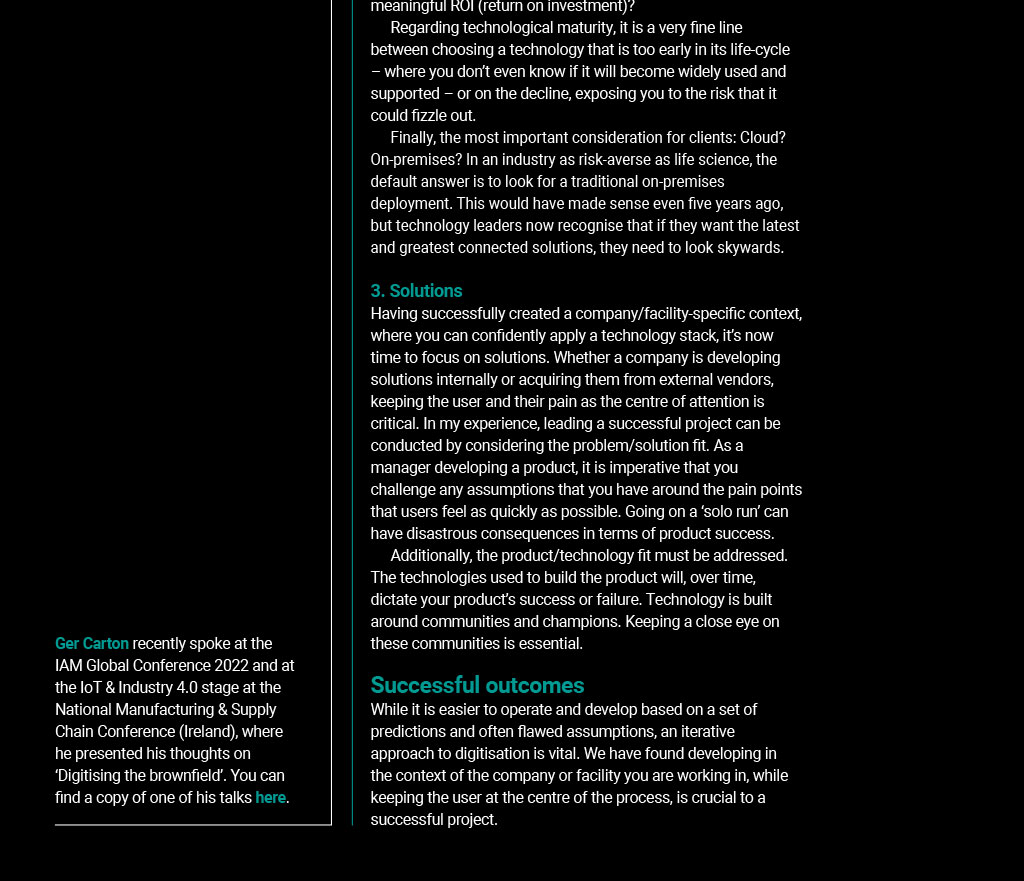




Opinion Digitising the brownfield Ger Carton, CEO of PlantQuest, is no stranger to the challenges and opportunities faced in digitising brownfield facilities. With more than two decades of experience working within the life science and oil and gas industries, he shares his tips W Ger Carton hile there is extensive capital investment in new facilities across the globe, most of the stock is brownfield in other words, it already exists. This means that the opportunity for both facility owners and solution providers can be found in the existing building stock. Brownfield facilities are old, have multiple owners in their lifecycle, and their information fidelity is well below that of greenfield facilities. Therefore, solution providers targeting the brownfield must do the hard things! Luckily for everyone involved, technology has made significant advances in the past decade, allowing brownfield digitisation to become more achievable. The steps needed In the initial stages of PlantQuest, we faced significant challenges in navigating the waters of digitisation in the global pharma sector. In the face of these obstacles, we developed a simple three-layer framework for expediting the time from initial conversation to a go/no-go decision on technology deployment. 1. Rules A major factor in the success of any solution is the technology choice Highly regulated industries are governed by a strict set of rules. Some rules are hard and fast, such as safety, security, IT, quality and so on. Some are more nuanced and human-centric, and very much depend on cultural norms and individual interpretations of risk. The hard and fast rules are good, you can learn them quickly and move on. The more nuanced rules are more difficult to figure out, and their interpretation and application can vary from person to person and company to company. We found that if a rule exists it means that you can get an answer. The goal at this stage is to digest the written rules and glean as much information as possible from stakeholders on the unwritten rules, so that you can begin to understand rules of business within an organisation. From a written rule or policy perspective, we focus on IT and security policies, procurement, infrastructure, and local and regional regulation. On the more nuanced side, it is all about talking to people and gauging the general themes that dominate the discourse within the organisation. 2. Tools The viability and longevity of a solution is key to its success. A major factor in the success of any solution is the technology choice. Foremost in our minds when a candidate technology or tool is being assessed, is its maturity and its applicability to the problem. First, on applicability to the problem, people need to find a balance between what is sold in the boardroom and what is practical in the plantroom. Choosing a VR solution for a mundane task might make it more exciting, but is there a meaningful ROI (return on investment)? Regarding technological maturity, it is a very fine line between choosing a technology that is too early in its life-cycle where you dont even know if it will become widely used and supported or on the decline, exposing you to the risk that it could fizzle out. Finally, the most important consideration for clients: Cloud? On-premises? In an industry as risk-averse as life science, the default answer is to look for a traditional on-premises deployment. This would have made sense even five years ago, but technology leaders now recognise that if they want the latest and greatest connected solutions, they need to look skywards. 3. Solutions Ger Carton recently spoke at the IAM Global Conference 2022 and at the IoT & Industry 4.0 stage at the National Manufacturing & Supply Chain Conference (Ireland), where he presented his thoughts on Digitising the brownfield. You can find a copy of one of his talks here. Having successfully created a company/facility-specific context, where you can confidently apply a technology stack, its now time to focus on solutions. Whether a company is developing solutions internally or acquiring them from external vendors, keeping the user and their pain as the centre of attention is critical. In my experience, leading a successful project can be conducted by considering the problem/solution fit. As a manager developing a product, it is imperative that you challenge any assumptions that you have around the pain points that users feel as quickly as possible. Going on a solo run can have disastrous consequences in terms of product success. Additionally, the product/technology fit must be addressed. The technologies used to build the product will, over time, dictate your products success or failure. Technology is built around communities and champions. Keeping a close eye on these communities is essential. Successful outcomes While it is easier to operate and develop based on a set of predictions and often flawed assumptions, an iterative approach to digitisation is vital. We have found developing in the context of the company or facility you are working in, while keeping the user at the centre of the process, is crucial to a successful project.